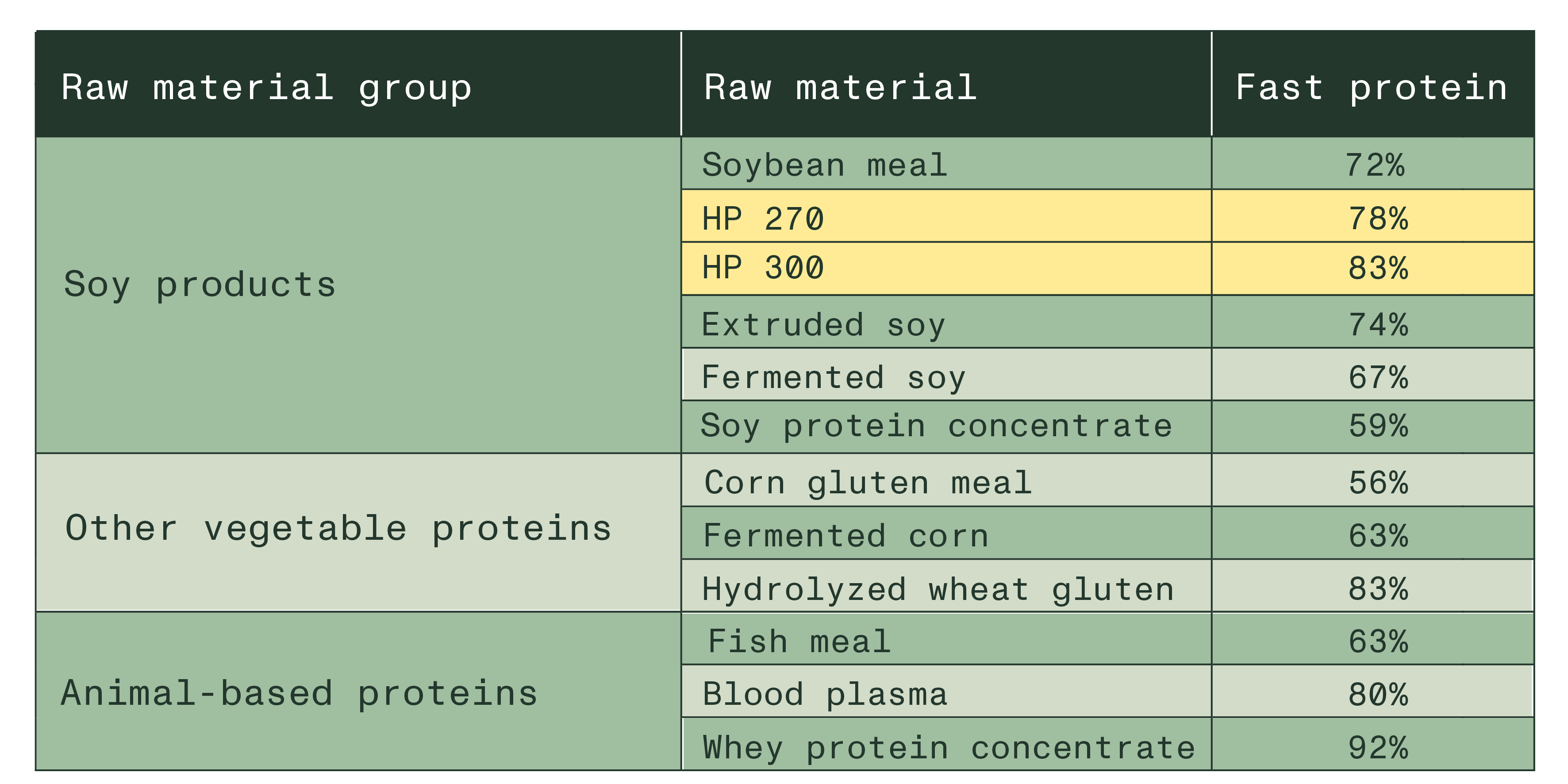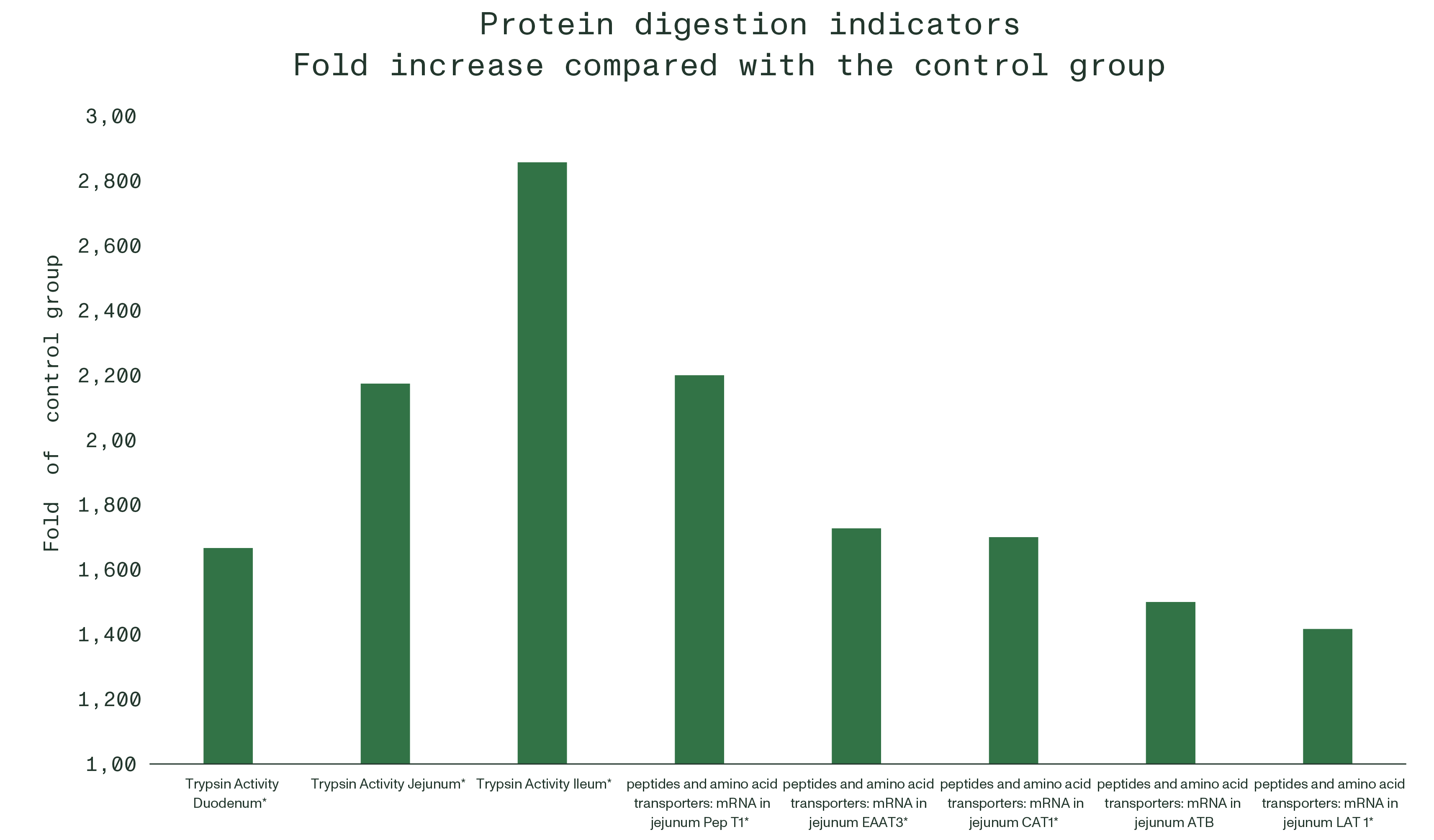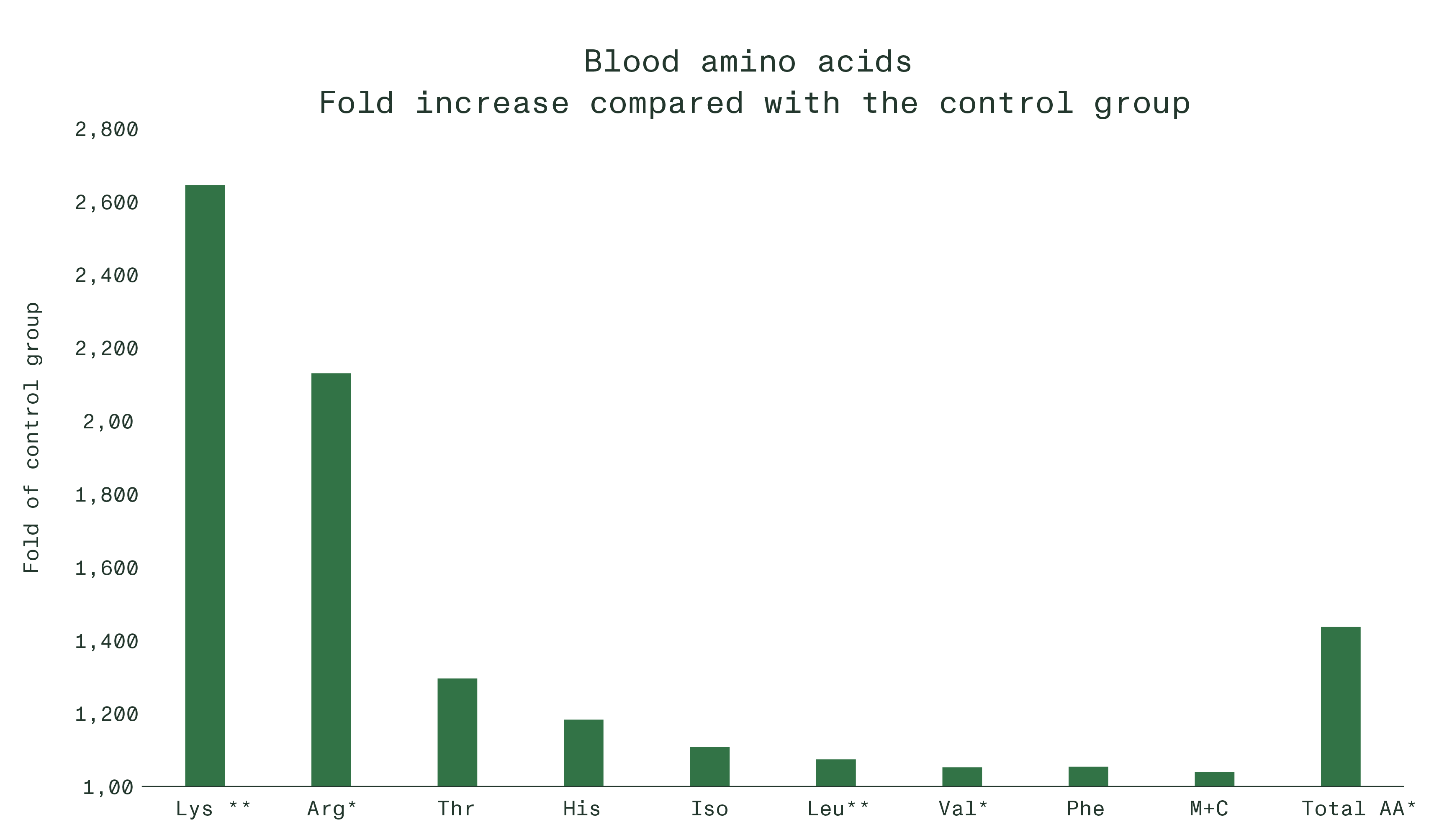Considerations for poultry nutritionists about early protein nutrition and digestive dynamics
By Marisabel Caballero, Category Manager Monogastrics
The debate of protein in poultry nutrition
In animal nutrition, diet cost and sustainability are amongst the most discussed topics. They are also among the most conflicting performance indicators for nutritionists: on one side, we must ensure the nutrients necessary for growth, health, and performance - using high-quality raw materials - and, on the other side, we must consider the cost of said raw materials, adding now the dimension of sustainability, including sourcing, carbon footprint, and reduction of emissions.
Protein has a crucial influence on both topics, as its quantity, quality, and source can make or break the performance and sustainability indicators of any operation at any given moment. When low-digestible or excessive protein is fed, undigested protein becomes available in the hindgut, which favors the growth of pathogens and thus compromises gut health, performance, and increases nitrogen excretion (Adhikari et al., 2025).
Soybean meal: the good and the bad
Soybean meal (SBM) is still the gold-standard source of dietary protein for poultry production, as it is highly available, affordable, digestible, and has an amino acid profile matching the needs of production animals. Though it presents some disadvantages, for instance, the presence of anti-nutritional factors (ANFs) such as trypsin inhibitors (TI) and indigestible galacto-oligosaccharides (GOS: stachyose and raffinose) as presented by García-Rebollar (2016). These ANFs reduce protein bioavailability and increase gut inflammation, affecting health and performance (Taliciero and Loveless, 2020; Teague et al., 2023), particularly in young birds (Ma et al., 2024).
Trypsin inhibitors can be deactivated by heat; however, a harsh heat treatment increases the risk of Maillard reaction, which ironically decreases the availability of the same nutrients that are hindered by TI, such as amino acids. Moreover, heat alone does not remove other ANFs like GOS.
A combination of an enzymatic process and a gentle heat treatment (Hamlet Protein) has demonstrated to reduce SBM ANFs as TI and GOS effectively, ensuring health and performance of young broilers, and having a carry-on effect throughout the production cycle, which translates into higher profitability for the operation (Steed et al., 2020).
A good start is crucial for success
The digestive tract of newly hatched poultry is in development and rapidly increasing in size, building up its structure, immune system, and microbial population (Apajalahti & Vienola, 2016). During this period, digestive enzyme secretion and nutrient transport systems also develop, particularly those related to protein digestion. For instance, broilers achieve peak protein digestion not before the third week post hatch (Ravindran and Abdollahi, 2021).
Thus, young animals require highly available nutrients for their proper development, which is reflected in the advice of poultry genetic guides to invest in starter feeds, setting the base for later growth and performance (Aviagen 2025; HyLine 2024).
Digestibility is not enough: placing digestive dynamics into the picture
Digestibility of raw materials is determined at the end of the small intestine; it represents the amount of nutrients that the animal can absorb and utilize (not considering microbial fermentation). These experiments do not contemplate that nutrient absorption takes place along the small intestine, and that starch is often digested and absorbed faster than protein (Liu et al. 2013).
Recent studies (Selle & Liu., 2019; Moss et al., 2018; Macelline et al., 2021; Toghyani et al., 2020; Macelline et al., 2025) have analyzed protein and starch digestion of various diets through the different segments of the intestine and concluded that net protein deposition in poultry is influenced by the synchronized availability of protein (amino acids) and energy (starch, glucose) at sites of nutrient absorption. Therefore, rapidly absorbable protein can reduce amino acid catabolism -to meet the energy demands of enterocytes- and enhance feed utilization (Macelline et al., 2021).
In summary, when digestive dynamics are considered, a proper blend of amino acids and energy sources is made available at sites of protein synthesis, resulting in efficient protein deposition. It is known that starch and glucose are absorbed in the upper intestinal segments. Therefore, increasing the quantity of readily available dietary protein will promote animal protein synthesis in the organs and tissues. However, the process is not simple and can be influenced by several factors, including feed density and composition (Chrystal et al, 2021; Macelline et al, 2020; Greenhalgh et al., 2022), and external factors as heat stress (Xu et al., 2024).
Fast protein in vitro and in vivo: research with ESBM
Fast protein sources with low ANFs, such as Hamlet Protein’s enzyme-treated soybean meal (ESBM), constitute an excellent source for critical-period diets, as starter feeds. An estimation of the quantity of fast protein in feed ingredients can be made by the pH-stat method: an in vitro assay for protein digestion speed. The pH-stat quantifies the progress of protein hydrolysis, measuring the acid released during the process (Bible et al., 2023). The results are visualized as curves, showing the degree of hydrolysis at each time point from 0 to 120 minutes; fast protein is defined as the proportion of hydrolyzed protein after 30 minutes.
As shown in Table 1, it can be assumed that around 80% of the protein in Hamlet Protein products -HP270 and HP300- is absorbed in the foregut and thus is more efficient at tissue deposition than other soy products and vegetable proteins, and comparable to good-quality animal-based proteins.

Table 1: Raw materials used in animal feeds and their proportion of fast protein, measured by the pH-stat assay.
A study by Ma and collaborators (2024) illustrates the benefits of Hamlet Protein’s ESBM at 5% of inclusion in starter broiler diets: after the feeding period of 10 days, body weight for the ESBM group was 6.5% higher than for the control group (p<0.05) and also 4.0% higher at the end of the cycle at 42 days (p<0.05), without significant differences in FCR in any period. This increased tissue accretion was influenced by higher and faster protein absorption in the broilers consuming ESBM, and was evidenced by:
- Increased trypsin activity in all intestinal segments (Figure 1)
- Higher jejunal mRNA expression of peptides (PepT1) and amino acid (EAAT3, ATB, CAT1, LAT1) transporters (Figure 1)
- Elevated levels of blood amino acids, indicating faster absorption, with a lysine level equivalent to 1.6 times the level in the control group (Figure 2)

Figure 1: Trypsin activity in duodenum, jejunum, and ileum; and mRNA expression of peptides and amino acid transporters of broilers fed with ESBM, as a fold of a control group fed a diet without Hamlet Protein’s ESBM. (*) indicate statistically significant differences with the control group (p<0.05). Adapted from Ma et al., 2024.
The lower content of trypsin inhibitors (1.3 for Hamlet Protein’s ESBM group and 4.2 for the control) contributed to the increased trypsin activity for the broilers in this group; moreover, some studies (Cervantes-Pahm& Stein, 2010; Ma et al., 2019) have estimated that Hamlet Protein’s ESBM has a higher quantity of small peptides than other high-value protein sources, which also influences peptide and amino acid absorption in the foregut, and thus the expression of their transporters in the jejunum.

Figure 2: Blood amino acids of broilers fed with ESBM, as a fold of as a fold of a control group fed a diet without Hamlet Protein’s ESBM. (*) indicate statistically significant differences with the control group (p<0.05). (**) indicate differences with the control group (p<0.01). Adapted from Ma et al., 2024.
These indicators can at least partially explain the excellent performance of poultry animals consuming diets with ESBM, which can be further supported by the results of 14 recent scientific trials made by Hamlet Protein in different countries and conditions, in which 5 to 10% inclusion of ESBM was compared with SBM-based starter feed in broilers, finding:
- An average of 3.8% higher body weight at the end of the starter phase (equivalent to 8.5 grams after 10 to 14 days),
- 4% higher body weight -an average of 92 grams- at the end of the cycle (36 to 42 days), thus for each gram of higher BW at the end of the starter period, the birds could increase about 10 grams at the end of the cycle.
- An average reduction of three points of FCR, both at the end of the starter period and at the end of the cycle.
These benefits make the decision to incorporate ESBM in starter feeds not only profitable but also sustainable.
In practice: keep an eye on fast protein sources
Practical research indicates that including fast protein in poultry starter diets has an economical return as it increases protein deposition and performance at the end of the cycle. However, the quantity of fast protein to include depends on different conditions.
In practice, with the current knowledge, it does make sense for poultry nutritionists to monitor and increase the quantity of fast protein in diets for critical periods, to observe their performance, and start making conclusions. In Hamlet Protein, we will continue with our research, as well as share our practical experience.
References
Adhikari, R., Rochell, S. J., Kriseldi, R., Silva, M., Greiner, L., Williams, C., Matton, B., Anderson, A., Erf, G. F., Park, E., Haydon, K., & Lee, J. (2025). Recent advances in protein and amino acid nutritional dynamics in relation to performance, health, welfare, and cost of production. Poultry Science, 104(3), 104852–104852. https://doi.org/10.1016/j.psj.2025.104852
Apajalahti, J., & Vienola, K. (2016). Interaction between chicken intestinal microbiota and protein digestion. Animal Feed Science and Technology, 221, 323–330. https://doi.org/ 10.1016/j.anifeedsci.2016.05.004
AVIAGEN. (2025). Ross Nutrition Supplement 2025. Aviagen North America, Hutsville, Alabama.
Bible, M. R., Rasmussen, P., Rasmussen, S. H., Blanch, A., van Leeuwen, J., Lærke, H. N., & Hedemann, M. S. (2023). PSXIV-23 In Vitro Evaluation of Protein Kinetics of Soy-Based Ingredients. Journal of Animal Science, 101(Supplement_3), 543–544. https://doi.org/10.1093/jas/skad281.639
Cervantes-Pahm, S. K., & Stein, H. H. (2010). Ileal digestibility of amino acids in conventional, fermented, and enzyme-treated soybean meal and in soy protein isolate, fish meal, and casein fed to weanling pigs1. Journal of Animal Science, 88(8), 2674–2683. https://doi.org/10.2527/jas.2009-2677
Chrystal, P. V., Greenhalgh, S., McInerney, B. V., McQuade, L. R., Akter, Y., de Paula Dorigam, J. C., Selle, P. H., & Liu, S. Y. (2021). Maize-based diets are more conducive to crude protein reductions than wheat-based diets for broiler chickens. Animal Feed Science and Technology, 275, 114867. https://doi.org/10.1016/j.anifeedsci.2021.114867
García-Rebollar, P., Cámara, L., Lázaro, R. P., Dapoza, C., Pérez-Maldonado, R., & Mateos, G. G. (2016). Influence of the origin of the beans on the chemical composition and nutritive value of commercial soybean meals. Animal Feed Science and Technology, 221, 245–261. https://doi.org/10.1016/ j.anifeedsci.2016.07.007
Greenhalgh, S., Lemme, A., Dorigam, P., Chrystal, P. V., Macelline, S. P., Sonia Yun Liu, & Selle, P. H. (2022). Dietary crude protein concentrations, feed grains, and whey protein interactively influence apparent digestibility coefficients of amino acids, protein, starch, and performance of broiler chickens. Poultry Science, 101(11), 102131–102131. https://doi.org/10.1016/j.psj.2022.102131
HyLine. (2020). HyLine W36 Management guide. HyLine International
Liu, S. Y., Selle, P. H., Court, S. G., & Cowieson, A. J. (2013). Protease supplementation of sorghum-based broiler diets enhances amino acid digestibility coefficients in four small intestinal sites and accelerates their rates of digestion. Animal Feed Science and Technology, 183(3-4), 175–183. https://doi.org/10.1016/j.anifeedsci.2013.05.006
Ma, X., Shang, Q., Hu, J., Liu, H., Brøkner, C., & Piao, X. (2019). Effects of replacing soybean meal, soy protein concentrate, fermented soybean meal or fish meal with enzyme-treated soybean meal on growth performance, nutrient digestibility, antioxidant capacity, immunity and intestinal morphology in weaned pigs. Livestock Science, 225, 39–46. https://doi.org/10.1016/j.livsci. 2019.04.016
Ma, C. L., Yin, Z. C., Zhang, X. Y., Zhang, C. X., Zhang, W. Y., Li, Y. X., & Yang, X. J. (2024). Dietary early addition enzyme-treated soybean improves amino acid absorption and protein digestibility by promoting digestive enzyme activity in broilers. Animal, 18(12), 101364–101364. https:// doi.org/10.1016/j.animal.2024.101364
Macelline, S. P., McQuade, L. R., Mclnerney, B. V., Moss, A. F., Selle, P. H., & Liu, S. Y. (2020). Protein digestive dynamics of meat and bone meals in broiler chickens. Animal Nutrition, 6(4), 521–528. https://doi.org/10.1016/j.aninu.2020.04.005
Macelline, S. P., Chrystal, P. V., Liu, S. Y., & Selle, P. H. (2021). The Dynamic Conversion of Dietary Protein and Amino Acids into Chicken-Meat Protein. Animals, 11(8), 2288. https://doi.org/ 10.3390/ani11082288
Macelline, S. P., Selle, P. H., Toghyani, M., & Liu, S. Y. (2025). The cost of amino acid catabolism for energy utilization in broiler chickens. Poultry Science, 104(7), 105199. https://doi.org/10.1016/ j.psj.2025.105199
Moss, A. F., Sydenham, C. J., Khoddami, A., Naranjo, V. D., Liu, S. Y., & Selle, P. H. (2018). Dietary starch influences growth performance, nutrient utilization and digestive dynamics of protein and amino acids in broiler chickens offered low-protein diets. Animal Feed Science and Technology, 237, 55–67. https://doi.org/10.1016/j.anifeedsci.2018.01.001
Selle, P. H., & Liu, S. Y. (2019). The Relevance of Starch and Protein Digestive Dynamics in Poultry. Journal of Applied Poultry Research, 28(3), 531–545. https://doi.org/10.3382/japr/pfy026
Steed, J., Blanch A., Moore D., Rasmussen S. & Brøkner C. (2020). A comparative analysis of an enzymatically processed soy protein and non-SBM protein sources on broiler live performance and economic benefit under NAE conditions. International Poultry Scientific Forum, Abstract T176.
Taliercio, E., & Loveless, T. (2019). Identification of immunogenic epitopes of two soybean glycinin proteins in chicken. Food and Agricultural Immunology, 31(1), 75–83. https://doi.org/ 10.1080/09540105.2019.1700930
Teague, K. D., G. Tellez-Isaias, Chai, J., V. Petrone-Garcia, Vuong, C. N., Blanch, A., Rasmussen, S. H., Brown, K., Zhao, J., & Rochell, S. J. (2023). Dietary soy galacto-oligosaccharides affect the performance, intestinal function, and gut microbiota composition of growing chicks. Poultry Science, 102(4), 102440–102440. https://doi.org/10.1016/j.psj.2022.102440
M. Toghyani, McQuade, L. R., Mclnerney, B. V., Moss, A. F., Selle, P. H., & Liu, S. Y. (2020). Initial assessment of protein and amino acid digestive dynamics in protein-rich feedstuffs for broiler chickens. Plops One, 15(9), e0239156–e0239156. https://doi.org/10.1371/journal.pone.0239156
Xu, M., Zhao, X., Yu, M., Wang, G., Feng, J., & Zhang, M. (2024). The amino acid pattern and dynamics of body protein, body fat deposition in male and female broilers under different temperatures. Poultry Science, 103(4), 103525–103525. https://doi.org/10.1016/j.psj.2024.103525
Events with Hamlet Protein
We attend events around the world. Meet us at exhibitions and seminars - we always look forward to welcoming you!
We also sponsor conferences with focus on young animal nutrition.
Have a look below where to meet us next.


